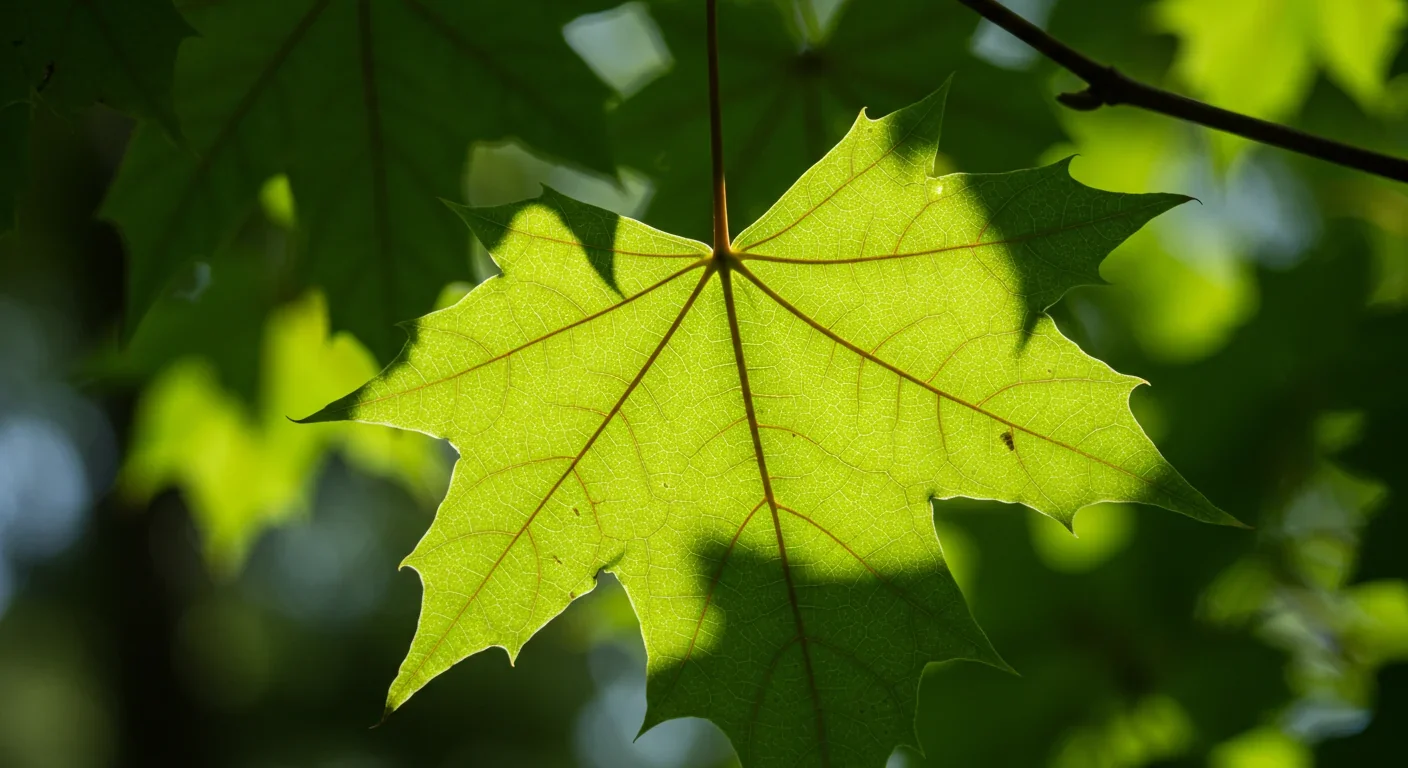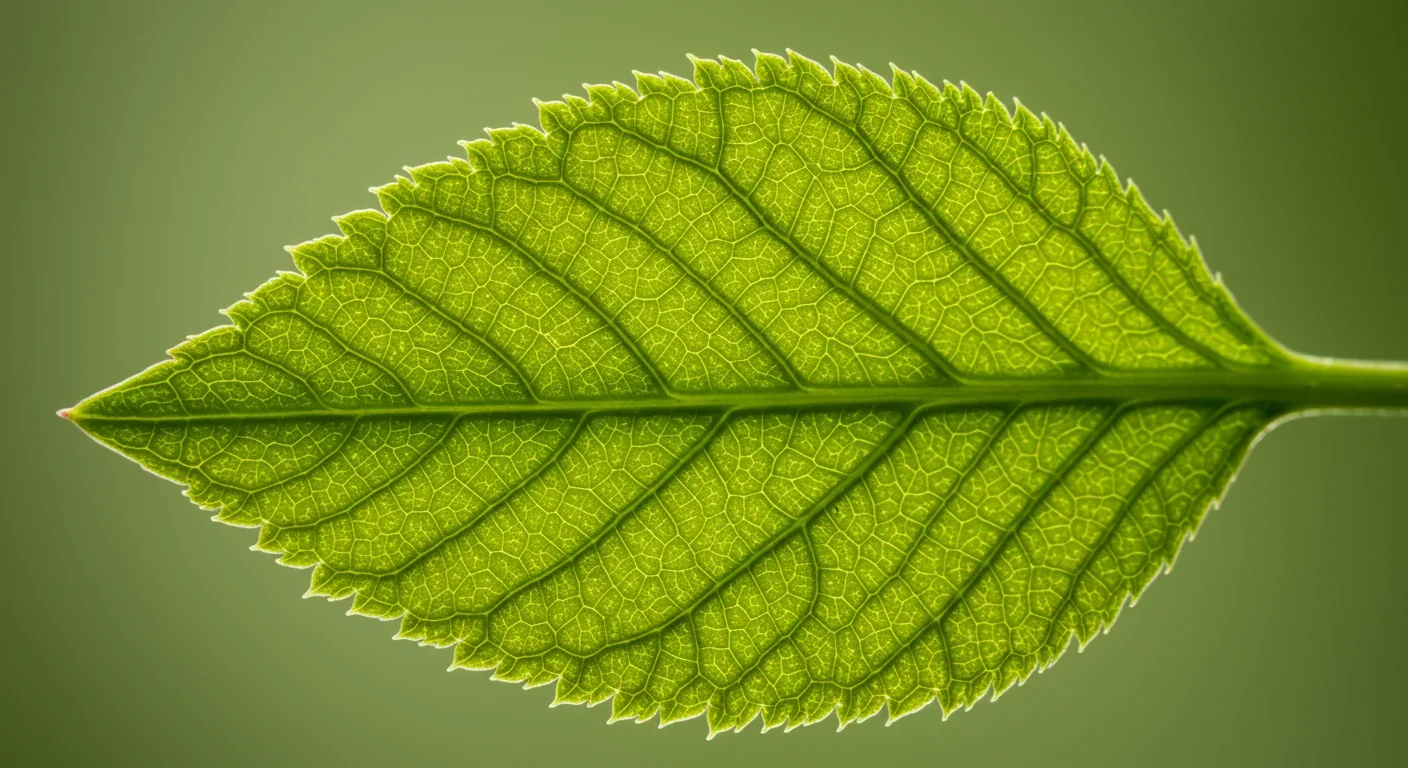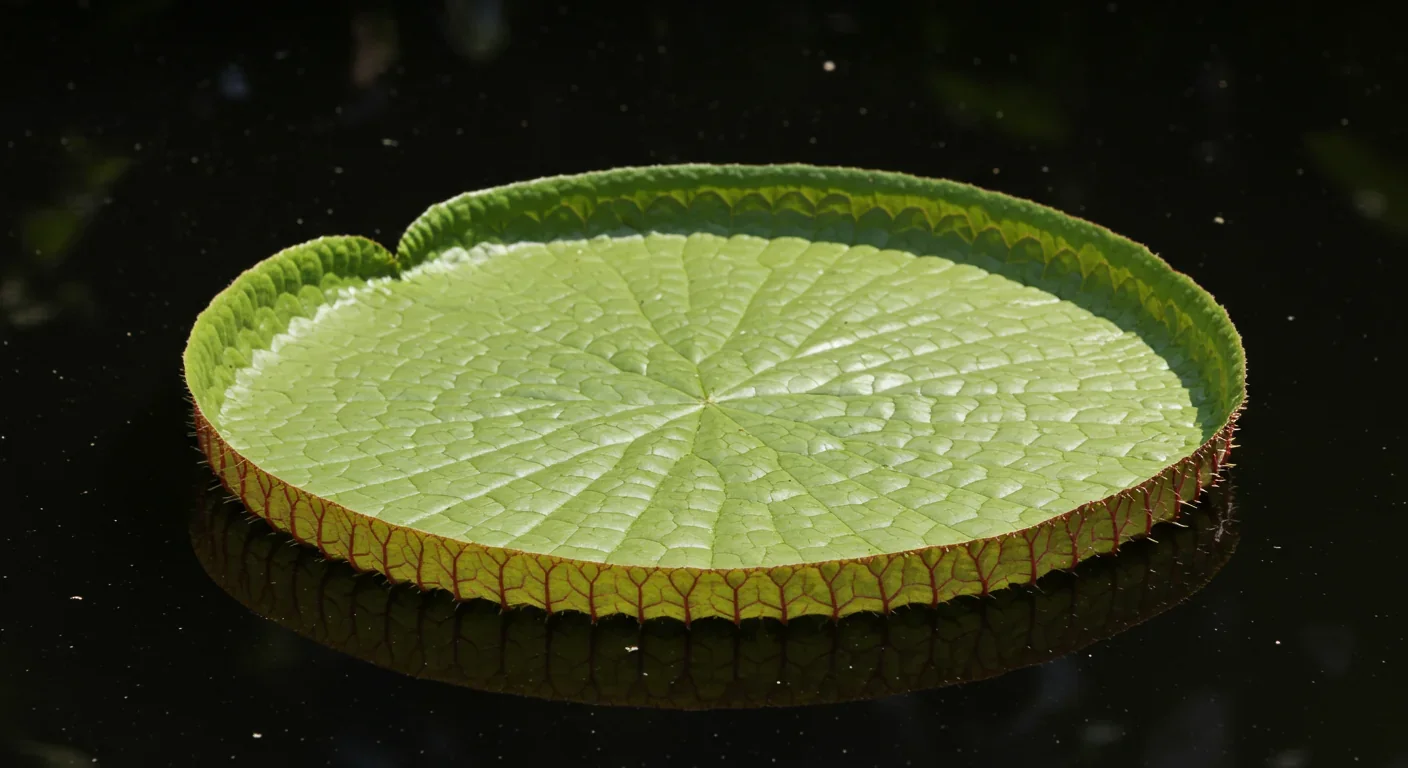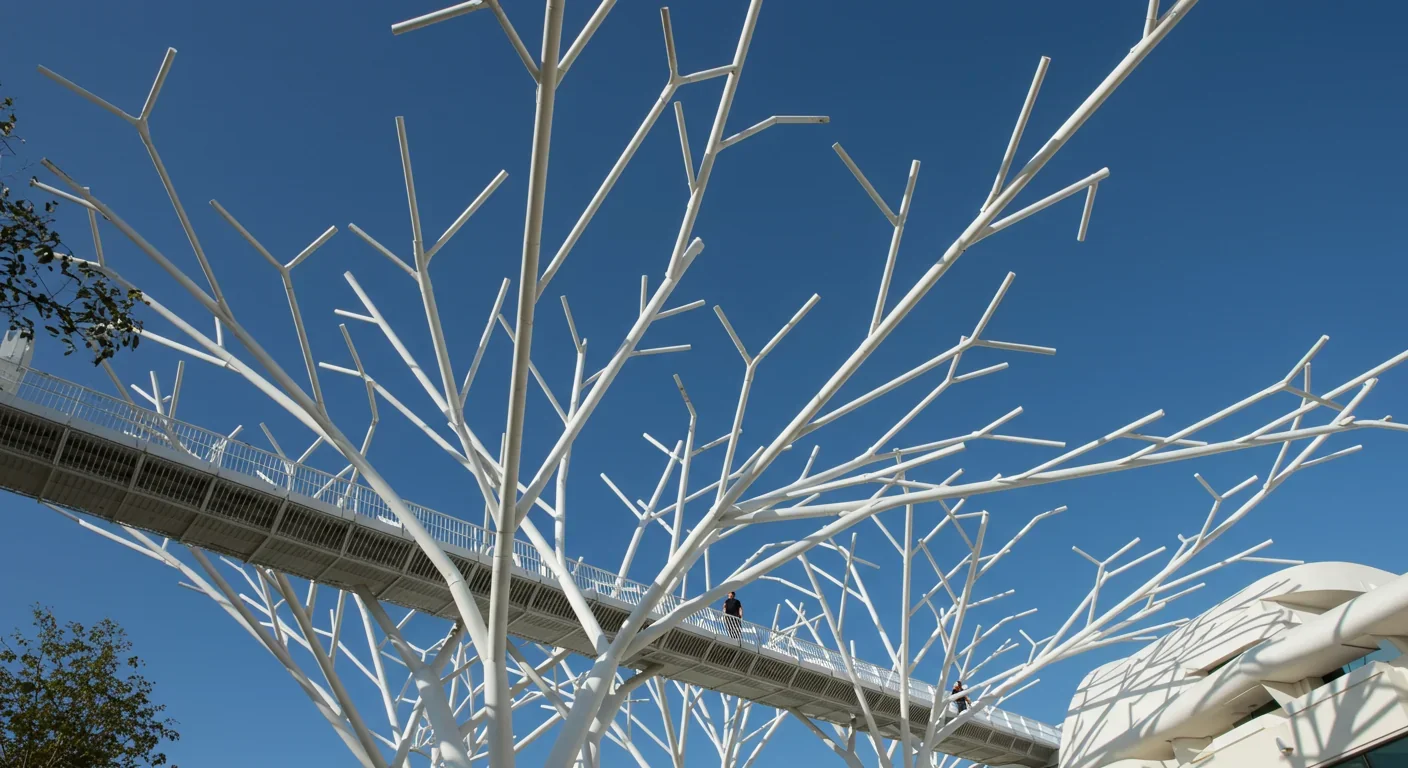Cuttlefish Pass Marshmallow Test: Alien Intelligence Decoded

TL;DR: Leaf veins follow fractal patterns governed by Murray's Law, creating mathematically optimal networks that maximize nutrient distribution while minimizing material costs. These same principles appear across nature—from blood vessels to river deltas—and now inspire human engineering solutions.
Hold a leaf up to the light. Those delicate veins branching across its surface look almost random at first glance, but they're anything but. They're following one of nature's most elegant mathematical solutions to a problem that has also stumped human engineers for decades: how do you build a distribution network that delivers resources efficiently to every point, using minimal materials, while staying resilient to damage?
The answer evolution discovered? Fractal geometry.

Every leaf faces a deceptively complex optimization problem. It needs to transport water from the stem to every photosynthesizing cell, then carry the sugars those cells produce back to the plant. Miss a spot and that patch of leaf becomes deadweight. Build too many veins and you waste precious energy and materials on infrastructure. Build too few and the system becomes a bottleneck.
Think of it like designing a city's water supply network, except the city keeps growing, the pipes have to self-assemble during construction, and you can't afford to waste a single molecule of building material because resources are scarce. Oh, and the whole thing needs to work perfectly on day one because there's no maintenance crew.
Plants solved this problem roughly 400 million years ago, and their solution turns out to be mathematically optimal in ways we're only beginning to understand.
Here's where it gets interesting. Fractal patterns are structures that look similar at different scales—zoom in and you see the same branching pattern repeated. The veins in a leaf follow this principle perfectly: large veins branch into medium veins, which branch into smaller veins, which branch into even tinier capillaries, each level looking remarkably like the others.
This isn't just aesthetic. It's functional brilliance.
Researchers at UCLA discovered that leaf venation follows a clear mathematical equation that scales with leaf size, regardless of other variations in structure or physiological activities. The fractal arrangement maximizes the surface area for photosynthesis while ensuring efficient transportation of water and nutrients throughout the entire leaf.
The fractal principle is nature's way of solving a massive optimization problem by applying a simple rule repeatedly at every scale.
The key insight? The same optimization principle applies at every scale. A major vein subdividing into smaller branches follows the same geometric rules as those smaller branches dividing further. This recursive pattern allows the plant to solve a massive optimization problem by applying a simple rule repeatedly.

The mathematical principle governing optimal vein architecture has a name: Murray's Law. Originally formulated to explain blood vessel branching, it describes the relationship between the diameter of a parent vessel and its branches.
The law states that the cube of the radius of a parent vessel should equal the sum of the cubes of the radii of the daughter branches. Mathematically: r³ = r₁³ + r₂³ + r₃³...
Why cube? Because this relationship minimizes the total energy cost of maintaining the vascular system and pumping fluid through it. Build your veins following Murray's Law and you get maximum transport efficiency for minimum material investment.
Recent research published in PLOS Computational Biology confirms that real leaf venation networks adhere remarkably well to Murray's Law, with the optimal vein conductivities following a power-law relationship with flux. The Murray exponent ranges from approximately 1.5 to 1.7 across different species—close to the theoretical optimum of 2.0 predicted by the law.
But here's what makes leaves even more sophisticated than a simple Murray's Law application: they don't just minimize transport costs. They also maximize robustness.
Early plants had simple tree-like venation—one main vein with branches that never reconnected. This is efficient in theory, but there's a fatal flaw: damage anywhere in the system cuts off everything downstream. One herbivore bite and part of your leaf is dead.
More sophisticated plants evolved something better: nested networks of interconnected loops. Biophysicists at Rockefeller University demonstrated that these complex looped structures provide the best distribution network for supplying fluctuating loads to varying parts of the system.
"For decades, people have believed that the tree-like network was optimal for fluctuating demand. But loopy networks challenge that assumption entirely."
— Marcelo O. Magnasco, Rockefeller University
For decades, operations researchers believed that tree-like networks were optimal for fluctuating demand. The leaf venation research overturned that assumption. Loopy networks can reroute flow around damage, providing multiple paths to any given point. This is why you can tear a chunk out of many modern leaves and the rest keeps functioning.
The mathematical model shows that the most robust system isn't purely tree-like or purely looped—it's a hierarchical network of nested loops. Major veins form the main highways, minor veins create local distribution networks with redundant paths, and the finest capillaries fill in any remaining gaps. Each level has loops, creating resilience at every scale.

How does a growing leaf actually generate these fractal patterns? It's not like there's a blueprint. Individual cells can't see the big picture to coordinate some grand design. Instead, the pattern emerges from local rules applied during development.
Leaf development proceeds in two distinct stages. First, the leaf expands slowly while forming major veins. Then comes a rapid growth phase that pushes these veins apart, creating space for new minor veins to form in between. This two-stage process inherently generates a self-similar, fractal-like network because each round of expansion and vein formation follows the same rules.
At the cellular level, the hormone auxin plays a crucial role. Auxin flows through plant tissues, and where it flows in high concentrations, vein tissue forms. But here's the elegant part: the process is self-reinforcing. Once a proto-vein starts forming, it becomes an easier path for auxin to flow, which encourages more vein development along that path.
This feedback mechanism is called canalization, and it's how local chemical signals organize into the global fractal architecture we observe. The mathematical models show that auxin flow through both specialized transport proteins and passive diffusion through cellular connections (plasmodesmata) work together to create these patterns. Even when one transport mechanism is blocked, the other compensates, providing robustness during development.
Self-organization is evolution's secret: complex order emerging from simple local interactions, with no central coordinator required.
It's a beautiful example of self-organization—complex order emerging from simple local interactions, with no central coordinator required.
Not all leaves solve the optimization problem the same way. While the underlying fractal mathematics is universal, different plant species show distinct venation strategies adapted to their specific environments and evolutionary histories.
Monocots like grasses typically display parallel venation—multiple primary veins running side-by-side with cross-connections between them. This pattern is efficient for long, narrow leaves and provides excellent redundancy since damage to one vein doesn't isolate large sections of the leaf.
Dicots—which include most broadleaf plants—usually exhibit reticulate venation with a single prominent midrib and an intricate mesh of branching veins. This creates a more complex network suited to broad, flat leaf blades where every point needs efficient access to the vascular system.
Even within reticulate venation, there's remarkable diversity. Some species optimize for maximum loopiness, creating dense meshes of interconnected veins. Others maintain more tree-like architectures with fewer loops, perhaps reflecting different evolutionary trade-offs between material costs and resilience.
Research analyzing full-scale leaf images across species found that a single parameter—the sink fluctuation coefficient, which represents how variable water demand is across the leaf surface—can differentiate between species' venation strategies. Each species has evolved an optimal balance between building redundant pathways and minimizing construction costs.
There's also a clear relationship between leaf size and vein architecture. Smaller leaves can get away with simpler venation because diffusion distances are short. Larger leaves need more elaborate vascular networks to ensure every cell stays supplied. This scaling relationship holds across different leaves worldwide, suggesting it reflects fundamental physical constraints rather than species-specific adaptations.

Understanding the mathematical rules governing leaf venation has unexpected applications to paleobotany. Leaf fossils are often fragmentary—you might find part of a leaf blade but not the whole structure. But because venation follows predictable scaling laws, scientists can now estimate the original leaf size from fragments by measuring the spacing of major veins.
Why does this matter? Because leaf size is strongly correlated with rainfall. Plants in wet environments can afford large leaves with lots of surface area for photosynthesis. Dry environments favor smaller leaves that conserve water. By reconstructing leaf sizes from fossils using vein spacing mathematics, paleobiologists can "hindcast" the rainfall and climate conditions that existed millions of years ago.
It's a remarkable application: the same fractal geometry that optimizes resource distribution in living leaves also encodes climate information that persists in the fossil record. The mathematics that evolved to solve a transport problem now helps us understand Earth's climatic history.
The fractal branching patterns in leaf veins aren't unique to plants. The same mathematical principles govern blood vessel networks in animals, the branching structure of trees, river delta formations, and even the organization of our lungs' airways.
Why? Because they're all facing fundamentally similar optimization challenges: distribute resources efficiently across a two-dimensional or three-dimensional space using a branching network, minimize the material and energy costs of building and maintaining that network, and maintain functionality even when parts of the system fail.
Murray's Law shows up in mammalian circulatory systems for exactly the same reason it appears in leaves—it represents the optimal balance between the metabolic cost of building blood vessels and the energy cost of pumping blood through them. River networks follow similar branching patterns because they're minimizing the energy dissipation as water flows from many small tributaries into larger channels.
"Fractal geometry isn't just a description of patterns in nature—it's a mathematical framework for understanding how optimization under constraints produces similar solutions across wildly different systems."
— Systems Biology Perspective
This universality is what makes fractal geometry so powerful. It's not just a description of patterns in nature—it's a mathematical framework for understanding how optimization under constraints produces similar solutions across wildly different systems. Whether you're a leaf evolving over millions of years, a developing embryo building a circulatory system, or erosion carving channels in rock, the same mathematics applies.
Human engineers are increasingly turning to leaf venation as inspiration for designing efficient distribution networks. The field of biomimicry studies natural systems to solve human design challenges, and leaf veins offer a master class in network optimization.
Cities face distribution problems remarkably similar to leaves: deliver water to every building efficiently, create transportation networks that remain functional despite disruptions, and optimize infrastructure investments. Traditional engineering approaches often produce tree-like hierarchies because they're easier to plan and build. But leaf-inspired looped networks could revolutionize urban infrastructure by providing the same resilience nature evolved.
Microfluidic devices—tiny laboratory-on-a-chip systems that manipulate minute fluid volumes—are already incorporating leaf-inspired channel networks. The fractal branching allows uniform distribution of reagents across the chip surface without complex pumping systems, exactly like leaves distribute water without a heart.
Supply chain and logistics networks could benefit from the same principles. Amazon's distribution centers, emergency response systems, even internet routing protocols all face the challenge of efficiently delivering resources under uncertainty. The mathematical models developed to understand leaf venation can inform these systems, suggesting how to balance cost, efficiency, and robustness.
There's even potential for architectural applications. Buildings need ventilation systems, heating and cooling networks, and structural support—all distribution problems that could be optimized using fractal principles. Some architects are already exploring designs inspired by natural branching patterns, finding that they often outperform traditional grid-based layouts.

What makes leaf venation mathematics so elegant is how it emerges from constraints rather than despite them. The plant can't afford to waste materials. It can't rebuild its vascular system if the initial design is flawed. It faces fluctuating demands and environmental stresses. These limitations don't prevent optimization—they define it.
The fractal solution works precisely because it respects these constraints while simultaneously maximizing multiple objectives: transport efficiency, material economy, spatial coverage, developmental simplicity, and resilience to damage. This multi-objective optimization is extraordinarily difficult to solve through deliberate design, yet evolution discovered it through incremental refinement over hundreds of millions of years.
The mathematics we use to describe leaf venation—fractal dimension, scaling laws, Murray's exponent—are human abstractions. The plant doesn't "know" it's following these rules. But the fact that we can describe natural vein networks with precise mathematical relationships reveals something profound: there are optimal solutions to certain classes of problems, and given enough time and variation, evolution reliably finds them.
Quantifying the fractal nature of leaf veins requires sophisticated analysis. Researchers use techniques like box-counting, where they overlay grids of different scales on images of leaf venation and count how many boxes contain vein segments. The relationship between box size and count reveals the fractal dimension—a measure of how completely the veins fill the two-dimensional leaf space.
A true one-dimensional line has a fractal dimension of 1.0. A solid two-dimensional surface has a dimension of 2.0. Leaf venation networks typically have fractal dimensions between 1.5 and 1.9, reflecting their intermediate status—more than a simple tree of lines, but not completely filling the space like a solid sheet.
Modern studies combine 3D scanning technology with computational modeling to analyze vein networks in unprecedented detail. Laser scanners can reconstruct the full three-dimensional geometry of veins, including their depth within the leaf tissue. Computer algorithms then extract the network structure, measure branching angles, quantify connectivity, and compare these measurements to theoretical optimal values.
One fascinating finding: the Royal Water Lily, with its giant circular leaves, shows fractal venation that provides not just transport efficiency but also mechanical strength. The vein network creates a rigid skeleton that can support enormous weight—up to 30 kilograms distributed across the leaf surface. The fractal geometry optimizes both fluid transport and structural integrity simultaneously.
The fractal principle extends beyond just vein networks. Tree architecture itself shows fractal branching from the trunk to major limbs to branches to twigs. Each level mirrors the overall form, creating self-similarity across scales from the whole tree down to individual leaf stems.
Some trees exhibit particularly striking fractal geometry. Conifers like pine trees display patterns reminiscent of the Sierpiński triangle, a famous mathematical fractal. Each branch resembles, in miniature, the overall structure of the entire tree. This hierarchical repetition emerges from the same growth mechanisms that organize leaf veins—local rules producing global patterns.
The Barnsley fern, a computer-generated fractal, demonstrates how simple mathematical rules can produce remarkably plant-like forms. The algorithm uses just four geometric transformations, applied randomly with specific probabilities, to generate a fern shape virtually indistinguishable from the real thing. This mathematical model suggests that the genetic instructions for plant form might be surprisingly compact—a few simple growth rules repeated at different scales.
The relationship between environment and venation runs deep. Plants in different climates face distinct optimization problems, and their vein networks reflect these challenges.
In arid environments, water conservation is paramount. Leaves tend to be smaller with denser venation networks that minimize the distance water must travel from veins to photosynthetic cells. This reduces water loss and allows the leaf to maintain function even under drought stress. The mathematical scaling reveals that dry-habitat plants consistently show tighter vein spacing relative to leaf size.
Tropical rainforest plants face the opposite problem: abundant water but intense competition for light. Their leaves are often larger with more elaborate venation that maximizes photosynthetic area while maintaining adequate water supply. The vein networks in these species typically show greater loopiness, providing redundancy that maintains function even when herbivores damage portions of the leaf—a common occurrence in high-biodiversity ecosystems.
Aquatic plants present another interesting case. Submerged leaves don't face the same water transport challenges as terrestrial species, since they're bathed in their growing medium. Many aquatic plants show reduced venation complexity compared to their terrestrial relatives, suggesting that much of the elaborate fractal architecture in land plant leaves specifically evolved to solve water distribution problems.
The evolution of reticulate venation allowed plants to produce much larger, more efficient leaves—a key evolutionary enabler that correlates with periods of plant diversification in the fossil record.
The evolutionary history is visible in the fossil record. Early land plants had simple dichotomous branching in their primitive leaves—each vein split into two equal branches, with no reconnection. This works adequately at small scales but becomes inefficient as leaves grow larger. The evolution of reticulate venation—where veins branch hierarchically and form loops—allowed plants to produce much larger, more efficient leaves. This innovation correlates with periods of plant diversification in the fossil record, suggesting vein network optimization was a key evolutionary enabler.
Our understanding of leaf venation mathematics continues to evolve. Recent computational models can now simulate the development of full-scale leaf vein networks, predicting the exact width and connectivity of individual veins based on hydrodynamic optimization principles. These models match real leaf data with remarkable accuracy, validating that we've identified the key optimization criteria evolution is working with.
Machine learning approaches are accelerating this research. Deep learning algorithms can now automatically extract vein networks from leaf images, quantify their properties, and compare them across thousands of species. This high-throughput analysis is revealing subtle patterns that manual measurements would never detect—species-specific signatures in vein architecture, correlations with ecological strategies, and responses to environmental stress.
There are still open questions. We don't fully understand how vein networks adjust during development if the leaf experiences stress or damage. The genetic basis for species differences in venation remains partially mysterious—which genes control whether a plant develops a densely looped network versus a sparser tree-like structure? And we're just beginning to explore how climate change might affect optimal venation strategies as temperature and rainfall patterns shift.
But the fundamental insight stands: leaf veins embody a mathematically optimal solution to a complex distribution problem, implemented through elegant developmental algorithms. They're proof that given sufficient time and variation, evolution can discover the same solutions that human mathematicians derive through abstract optimization theory.
Understanding leaf venation mathematics isn't just an academic exercise. It connects us to the fundamental principles that shape biological organization and offers practical tools for human design challenges.
Every time you look at a leaf, you're seeing evolution's answer to an engineering problem that still challenges our best computer algorithms. The fractal patterns aren't decoration—they're functional elegance refined over hundreds of millions of years. Those veins represent an optimization so precise that we can describe it with mathematical laws, yet so adaptable that it works across millions of species in every environment on Earth.
The same principles that deliver water to every cell in a leaf could optimize our cities' infrastructure, improve medical devices, enhance computer networks, and inspire entirely new classes of technologies. Nature has already solved problems we're still working on.
And there's something almost philosophical about this: the mathematics we use to understand leaves—fractals, scaling laws, optimization theory—are human inventions. We created this language to describe patterns we observed. Yet the patterns themselves existed long before we evolved to notice them. The leaves were following Murray's Law millions of years before Cecil Murray formulated it in 1926.
This suggests that mathematics isn't merely a human construction. It's a language for describing relationships and constraints that exist independent of us. The reason mathematical models of leaf venation work so well isn't because we're imposing our framework on nature—it's because we've discovered nature's framework. The universe operates according to principles that can be expressed mathematically, and evolution explores this possibility space, finding solutions that we can recognize as optimal when we finally work through the equations ourselves.
So next time you pick up a leaf, look closer. Those veins aren't random. They're a mathematical proof—written in chlorophyll and cellulose—that the same elegant principles govern systems from the molecular to the cosmic scale. They're a reminder that underneath the messy complexity of the natural world lies a hidden order, waiting for curious minds to uncover it.

Curiosity rover detects mysterious methane spikes on Mars that vanish within hours, defying atmospheric models. Scientists debate whether the source is hidden microbial life or geological processes, while new research reveals UV-activated dust rapidly destroys the gas.

CMA is a selective cellular cleanup system that targets damaged proteins for degradation. As we age, CMA declines—leading to toxic protein accumulation and neurodegeneration. Scientists are developing therapies to restore CMA function and potentially prevent brain diseases.

Intercropping boosts farm yields by 20-50% by growing multiple crops together, using complementary resource use, nitrogen fixation, and pest suppression to build resilience against climate shocks while reducing costs.

Cryptomnesia—unconsciously reproducing ideas you've encountered before while believing them to be original—affects everyone from songwriters to academics. This article explores the neuroscience behind why our brains fail to flag recycled ideas and provides evidence-based strategies to protect your creative integrity.

Cuttlefish pass the marshmallow test by waiting up to 130 seconds for preferred food, demonstrating time perception and self-control with a radically different brain structure. This challenges assumptions about intelligence requiring vertebrate-type brains and suggests consciousness may be more widespread than previously thought.

Epistemic closure has fractured shared reality: algorithmic echo chambers and motivated reasoning trap us in separate information ecosystems where we can't agree on basic facts. This threatens democracy, public health coordination, and collective action on civilizational challenges. Solutions require platform accountability, media literacy, identity-bridging interventions, and cultural commitment to truth over tribalism.

Transformer architectures with self-attention mechanisms have completely replaced static word vectors like Word2Vec in NLP by generating contextual embeddings that adapt to word meaning based on surrounding context, enabling dramatic performance improvements across all language understanding tasks.